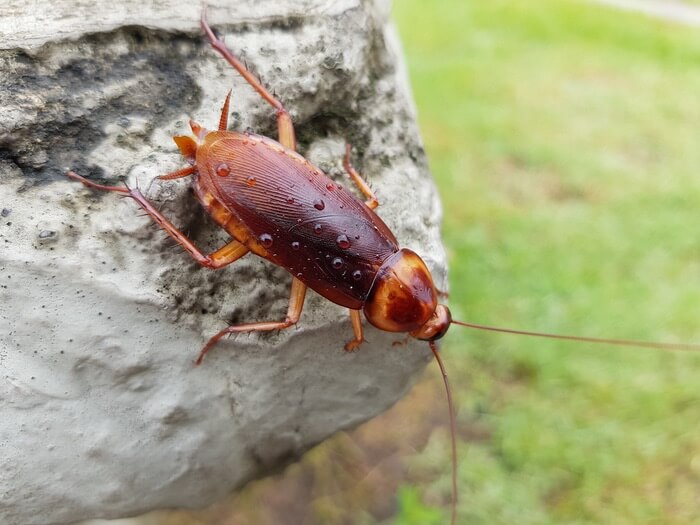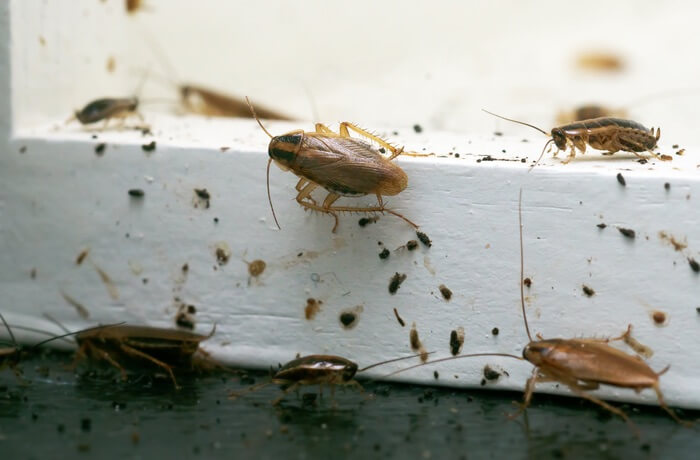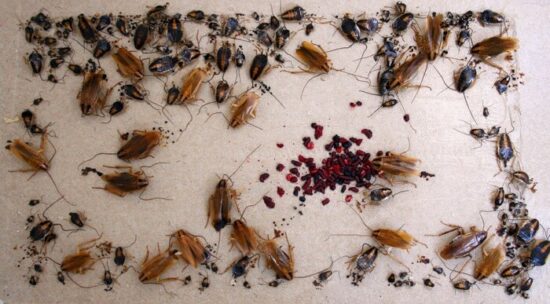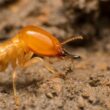When comparing German cockroaches vs. American cockroaches you’ll find many similarities, but a few important differences.
Read this guide to learn what makes each unique, and how to tell them apart.
Table of Contents
American Cockroaches
American cockroaches are the largest home-invading species in the United States. In fact, when you compare German vs. American cockroaches, their size is one of the biggest differences.
They’re sometimes referred to as waterbugs and frequently misidentified as the Palmetto bug. Whatever you call them, these pests are some of the most intimidating.
They have a relatively large footprint and often invade homes in creative ways.
Appearance
These roaches have many of the same physical traits as other species. However, subtle and not-so-subtle differences make them pretty easy to identify with a brief glance.
The most obvious identifier is the size. American cockroaches are about an inch and a half to two inches long. Some can even grow slightly larger, reaching lengths of about two and a quarter inches.

Like other roaches, this species of cockroach has six legs with large, prickly hairs. Two thin antennae sprout from the head as well.
When it comes to color, American roaches take on a reddish-brown color vs. the darker color of German cockroaches. The rusty hues are more prominent in the light, but the coloration is noticeably different than the standard brown on other insects. In addition to the overall reddish-brown hues, you’ll notice faded yellow along the edges of the thorax.
Another defining characteristic is the wings. American cockroaches have long and functional wings. While these pests stick to the ground in most situations, they’re fully capable of flying. Some will even fly directly at you when startled!
On females, the wings are about the same length as the abdomen. However, they extend beyond the tip of the abdomen on males.
The younger roach nymphs look like miniaturized versions of the adults, but they lack the defined wings of mature bugs.
Natural Habitat
Before they get into your home, American cockroaches typically reside in warm, moist environments. They like to stick to areas with temperatures around 70 to 80 degrees. As a result, these pests are widespread in the South and other tropical regions.
The roaches stick to humid habitats with easy access to decaying organic matter. You might see them living in hollow trees, decomposing woodpiles, and heavily wooded areas with tons of plant waste.
If you live in an area with tons of trees and lots of canopy coverage, these roaches likely reside around grass-free soil. Don’t be surprised if you find them around landscaping mulch, too. Any place that’s humid and dark is perfect for this cockroach.
Where To Find Them In Your Home
American cockroaches tend to migrate indoors when they experience food shortages or whenever the climate shifts. However, they will often venture into homes to scavenge even if they dwell outside.
Like their outside environment, American roaches prefer to stick to damp, dark, and humid areas. They often come up from sewer systems, and large storm drains. Some will live there long term, but many use those systems to get to safer parts of the house.
Once inside, these roaches move to utility rooms, attics, and basements. They can also establish harborages behind your walls or any other void that’s conducive to their lifestyle.
Quick Tip: If you have any unknown water leaks, don’t be surprised if you find American roaches nearby. Not only does the leak serve as a valuable source of water, but it also creates just enough humidity to keep them comfortable.
How To Get Rid Of Them
Successfully exterminating American roaches can be tricky. In the contest of American vs. German cockroaches, neither one is considered “easy” to remove. Despite their large size, American cockroaches are master escape artists. They typically reside in places that humans don’t frequent.
Roach populations can get massive before you even notice that an infestation is occurring under your nose. To make matters worse, finding and accessing American roach harborages is never an easy task.
The best way to get rid of American cockroaches is to use bait traps. Whether granular, liquid, or powder-based, traps can ensure that the poison affects the entire colony.
Slow-acting poisons give the roaches enough time to bring the bait back to the nest. By the time the roaches start dying off, the poison has already made its way around. Pair that with cannibalistic behavior, and bait traps can be very effective.
Many exterminators also recommend perimeter sprays and dusting. Those methods can prevent additional roaches from getting into your home. Plus, the insecticides can stunt the development of nymphs and eggs to stop population growth in its tracks.
German Cockroaches
German cockroaches are the most common species to invade homes. When many people look up “German roaches vs. American roaches” they end up discovering that the German variety is the one in their home.
Infestations are widespread thanks to this pest’s adaptability and relative fearlessness. Unlike other variants that stay out of sight, German roaches are more daring in their pursuits.
There’s a good chance that you’ve encountered one at some point. While it looks similar to other species, German cockroaches have several defining characteristics.
Appearance
Mature German cockroaches are nowhere near as big as their American counterparts. Fully grown bugs are only half an inch long. Some may grow slightly larger, but they don’t exceed five-eighths of an inch in size.

This pest has the signature oval-shaped body, six legs, and slender antennae. Its color is closer to a traditional tan to light-brown color. When compared to American roaches, the German variety is noticeably darker and has a much cooler tone.
If you get close enough to notice more delicate details, you’ll see a pair of parallel lines. The stripes are slightly darker than the surrounding tan, resulting in visible contrast. They run vertically from the top of the head down to the wings.
Quick Tip: Speaking of which, German Roaches do have defined wings. However, this species cannot fly. While non-functional, the wings are prominent. They sit on top of the body and take on a waxy finish.
Natural Habitat
One of the most impressive aspects of a German cockroach is its adaptability. This is partly why they’re such common pests!
You’re most likely to find these bugs living in tropical environments. They prefer to live in warm and humid habitats. Ideal temperatures are between 70 and 75 degrees Fahrenheit.
All that said, this species is surprisingly resilient in harsh climates. In colder areas, they almost exclusively live in human dwellings. They’re incapable of surviving in snow or extreme cold, but they will find a way to get into safe structures.
This bug’s determination isn’t just a myth. German roaches have been found as far north as Nunavut, Canada, the northernmost continuously inhabited place on Earth!
Of course, populations in those climates are scarce.
Most German roaches reside in temperate climates, where they find shelter near heat-producing structures.
Where To Find Them In Your Home
Of all the cockroach species in the world, German cockroaches are more likely to inhabit human-built structures vs. American cockroaches. German roaches will live anywhere that’s warm, safe, and close to the resources they need to survive.
While American roaches stick to sewage drains and basements, the German variety will invade rooms that you use frequently. They like to live in kitchens and bathrooms, as those spaces offer direct access to food and water.
You’re not likely to run into German roaches in the open. Despite living close to humans, these bugs still prefer to stay out of sight when possible.
The roaches often live in hidden voids behind walls or cabinets. They can set up shop in cracks located in your floor and backsplash tiles, too. Other potential hiding spots include holes around plumbing, drawer wells, and underneath appliances.
Some homeowners find them living around showers and toilets as well. Splash-prone areas are perfect thanks to easy access to water and ample humidity.
If you have motor-driven appliances, there’s a good chance that you’ll find German roaches nearby. Refrigerators and dishwashers have motors that produce a significant amount of residual heat. The added warmth naturally attracts them.
How To Get Rid Of Them
Getting rid of German roaches can be a monumental challenge. German cockroaches vs. American cockroaches have a very different level of difficulty! These critters have a relatively quick lifecycle. As a result, they can lay hundreds of eggs in only a matter of weeks!
Exterminators typically recommend multiple techniques to tackle infestations from all directions.
Insecticide sprays are great for addressing visible roaches in easy-to-access locations. For example, you can use readily available sprays to kill any insects you find in your kitchen cabinets or underneath appliances. Many products also work well on surfaces the roaches walk on.
To take care of roaches residing in cracks and voids, you can utilize aerosol sprays, foams, and more.
For the well-hidden pests, bait traps are the go-to solution. Bait traps utilize slow-acting poison. Scouts and workers can bring the bait back to the nest and inadvertently kill the entire colony.
Residual insecticides and perimeter sprays can provide results as well.
Gas-based bombs and sprays with potent fumes can offer impressive results, too. Whole-home extermination products often include insect growth inhibitors. They decrease or eliminate egg production. Not only that, but the inhibitors can kill or stop the development of nymphs.
Quick Tip: Exterminating German cockroaches is not a quick process. In most cases, it involves repeat spray applications and constant monitoring of bait. Even then, there’s always a possibility that the roaches can return.
Many people associate German roaches with filth and garbage. While they do live in dirt and grime, any house can harbor these pests.
To ensure that they don’t take over, keeping your property clean and clutter-free is paramount. The same goes for adopting a regular pest prevention plan with routine treatment.
Is One Preferable To Another?
It’s not ideal to have any type of cockroach in your house. Both of these species are capable of spreading disease-causing pathogens, bacteria, parasites, and more. There’s a genuine threat of roaches creating an unhealthy environment that makes you sick.
Not only do they spread diseases, but they leave a wake of filth everywhere they go! From dried-out exoskeletons that trigger allergies to parasite-filled poop pellets, American and German roaches are not something you want to have in your home.
In the battle of American roaches vs. German roaches, there’s clearly one species that’s easier to deal with. American roaches are generally considered the lesser of two evils.
German roaches pose several unique problems. First, they’re a lot more prevalent. This species can multiply very quickly, so it doesn’t take long for infestations to go out of hand.
Secondly, German cockroaches live closer to humans. While they still try to stay out of sight, they don’t shy away from entering your bathroom or kitchen. American roaches are more likely to live in crawl spaces and basements where people rarely go.
Because German roaches are fearless and adaptable, there’s a greater chance that you’ll inadvertently encounter their filth. They can walk on your food, leave behind droppings, and spread disease wherever they go!
Finally, there’s the issue of allergies. Medical studies show that German cockroaches are responsible for spreading allergens that can trigger asthma attacks. The risks are more significant for children.
Large infestations can make your home into an allergen-filled nightmare! For this reason, addressing German roach issues should always be a priority. Don’t ignore stray roaches. If you see one out in the open, there’s likely plenty of more hiding in the shadows.
Closing Thoughts
If you look at American roaches vs. German roaches, there isn’t a whole lot to tell them apart. These insects are confused for one another all the time!
But once you know the subtle differences in their appearance and behavior, you’ll be able to remove and prevent infestations a bit easier.


